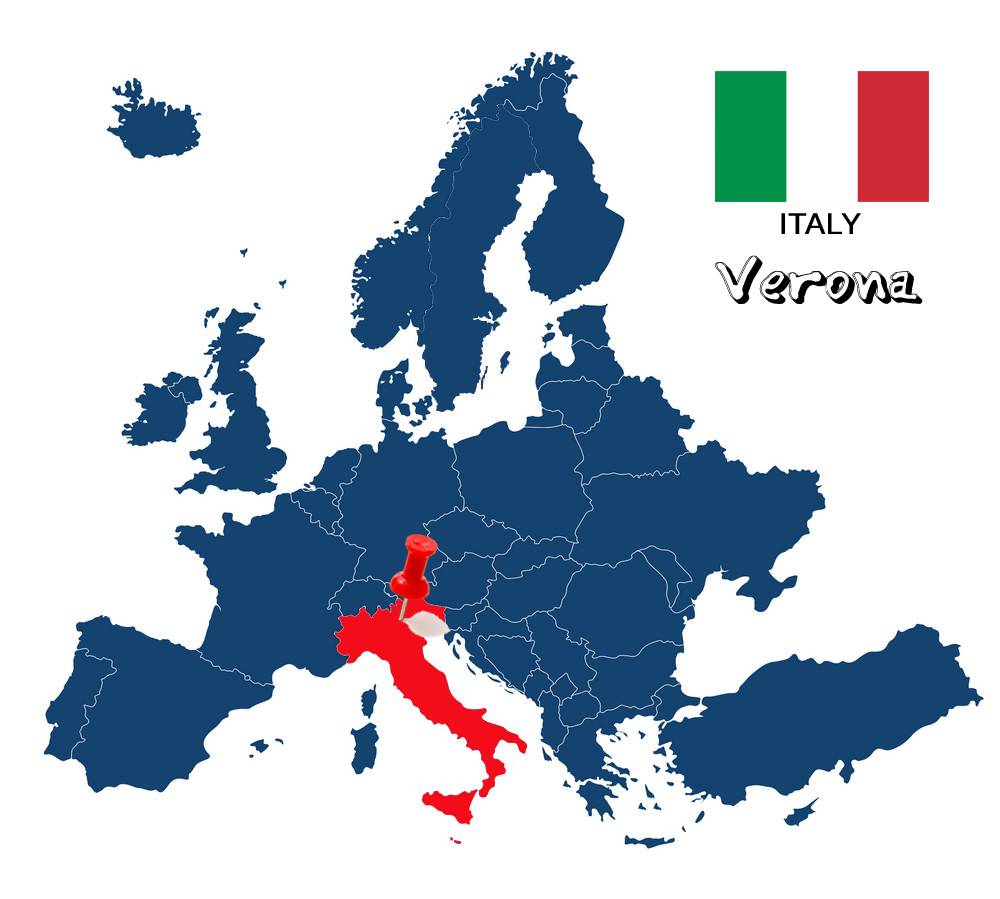
Verona was the first city I visited abroad after the outbreak of Covid-19 and was done in collaboration with Visit Verona. Anyone who follows me knows very well the love I have for Italy, having explored a significant part of the neighboring country. After this trip, however, I declare myself in love with Verona and rank it at the top of the Italian cities I have visited!
A few words about the city
Verona is located in northern Italy and more specifically in the region of the Veneto. It is built on the banks of the Adige River and has been included in the UNESCO World Heritage Sites due to its urban structure and architecture. The population of the municipality of Verona reaches 265,000 inhabitants, being the second largest urban municipality of Veneto, after Venice and the third largest in northeastern Italy. It is one of the main tourist destinations in the Italian North, thanks to its artistic heritage, annual exhibitions and lyrical theater performances in the famous Arena, the ancient amphitheater built by the Romans. But it is more famous because of Shakespeare, three of whose works, most importantly Romeo and Juliet, take place there! So I have chosen for you, what I consider to be worthy of attention for someone who is visiting the city for the first time.
Arena di Verona
A proper exploration of Verona always starts from Square Bra (Piazza Bra), where the Arena of Verona (Arena di Verona) dominates. It will strongly remind you of the Colosseum in Rome, except that this amphitheater is very well maintained and is still used for concerts! It is the third largest arena in the world, which at the time it was built, in 30 AD, had a capacity of 30,000 spectators! In 117 AD during a major earthquake, among other things, the outer ring of the arena was almost completely destroyed and the broken marbles of the building were used to create new buildings in the city in the centuries that followed. Excavations in the arena brought to light a complex of water pipes, which allowed water to enter the amphitheater. The water was used both as an impressing game in the various performances that were played, as well as to clean the space after the hard duels that took place in the Arena. The entrance to the arena costs 10e.

Casa di Giulietta
As you probably know, Shakespeare's story is fantastic, and Romeo and Juliet never really existed. In 1930, however, the municipality of Verona bought a random house that resembled the author's description and turned it into the house of Juliet (Casa di Giulietta). This house dates back to the 13th century and actually belonged to the Del Capello family, while today it is included in the UNESCO World Heritage Sites! The queues for Juliet's house are usually huge, with people flocking to be photographed on the iconic balcony and with the bronze statue of Juliet. In fact, the legend says that rubbing her right breast will bring you luck! The entrance to the courtyard where the statue is located is free, but to enter the residence the ticket costs 6e. Inside the house there are some of the costumes of Shakespeare's first play, paintings and Juliet's bedroom. Finally, with about a ten minute walking you can visit the tomb of Juliet (Tomba di Giulietta). And here the entrance to the garden is free, but if you want to enter the museum you have to pay a price of 4.5e.

Castel Vecchio
The old castle (Castel Vecchio) is one of the most iconic sights of the city. Built in 1350 on the banks of the Adigi River, it was for years the home of the Scalighieri dynasty. It has suffered many destructions and bombings over the centuries, most notably those that took place during World War II. The damage was so severe that there were even thoughts of demolishing the building! Fortunately, with the contribution of the then leadership and the Italian architect Carlo Scarpa, the castle was reborn from its ashes, reminiscent of its old glories. It is worth walking the impressive castle bridge (Ponte di Castel Vecchio) and visiting the museum housed inside (Museo di Castelvecchio). There you will admire magnificent renaissance paintings, statues, murals, jewelry and various medieval objects. Admission costs 6e.

Piazza del Erbe
The Market’s Square (Piazza del Erbe) is Verona's most famous square and the place where the heart of the city beats. At its center is an open-air market with stalls selling literally everything from local snacks and fruit to clothes, shoes and souvenirs. Around the square you will find many cafes, bars and restaurants, ideal either for a relaxing coffee or aperitivo or for food overlooking the square.
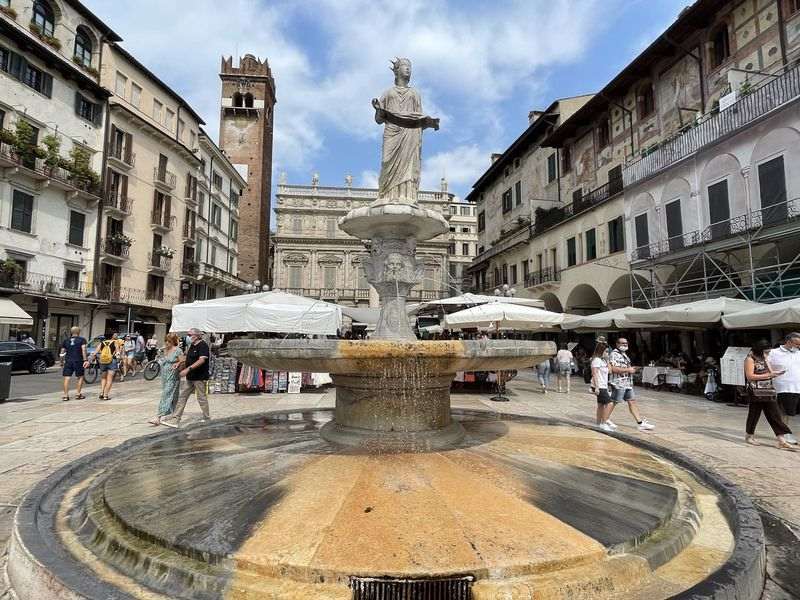
To the right of the square, you will see an impressive arch, accompanied by a strange story. From the arch of Constantine (Arco della Costa) or arch of the flank, as the locals call it, hangs a whale side for more than 1,000 years! According to legend it is not going to fall until a man who has never lied has passed underneath! And although many representatives and leaders of the Papal Church, as well as many leaders and kings, have passed by, the side of the whale still stands there!
Passing under the arch you will find yourself in another attractive square, the Men Square (Piazza dei Signori) or as it is often called "the outdoor lounge". The square is surrounded by Renaissance palaces, such as the Palace of Scaligeri (Palazzo degli Scaligeri-Palazzo Podestà) and the Palazzo di Cansignorio. In the center of the square is still the statue of Dante, who found refuge in Verona when he was exiled from Florence in 1302.
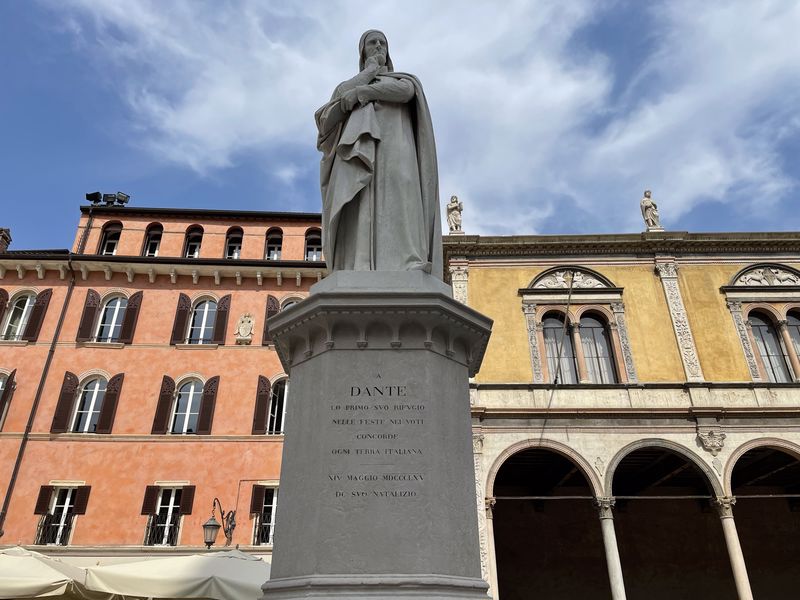
Finally, right next to it, are the tombs of the Scaligeri (Arche dei Scaligeri). These are five Gothic tombs of the Scaligeri family, who ruled in Verona from the 13th to the end of the 14th century. Admission costs 1e.
Torre dei Lamberti
In Verona there are many places where one can see the city from above. Located in the old town and more easily accessible is the Lamberti Tower (Torre dei Lamberti). This is an 84-meter tower, which began to be built in 1172 and was completed in 1463! As it is easily understood, due to the many centuries that took to complete the project, different materials and styles have been used by the architects. Also, the large clock was added in 1779, while the spiral staircase inside the tower in 1972! In contrast to similar attractions, you can climb to the top of the Lamberti Tower by lift! Of course, because the number of people allowed inside is 9 people, the queues at the entrance are usually huge and the wait is extremely long. Finally, keep in mind that every half hour the two giant bells of the tower ring each other, reminding passers-by of the time, so if you are downstairs do not panic. The entrance to the tower costs 6e.
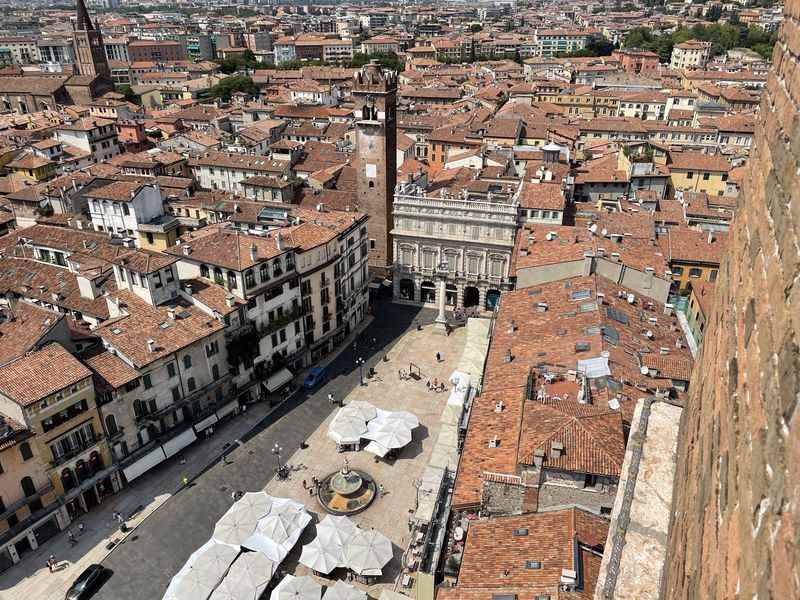
Castel San Pietro
The other place from which you can admire Verona from above is just outside its historical center. Cross the bridge of Peter (Ponte Pietra) over the river Adige and soon you will be faced with the castle of St. Peter (Castel San Pietro) on the homonymous hill. Do not expect to see an impressive building, since this medieval castle is known mainly for its supernatural views and not for its magnificence. You can climb the fortress either traditionally by its hundreds of stone steps or by cable car, which costs just 2e and will leave you in a minute at the top. In fact, according to the locals, this spot is the best to admire the sunset in Verona!
The churches
Every self-respecting Italian city has its own trademark church. In Verona, however, there are more than one churches worth visiting. For me, the most impressive of these is the Basilica of St. Anastasia (Basilica di Santa Anastasia). It’s a magnificent temple of Gothic architecture, located near the oldest part of the old town, next to the Ponte Pietra. The present church began to be built in 1280 and was completed in 1400, designed by the Dominican priests Fra 'Benvenuto da Imola and Fra' Nicola da Imola, while it took its name from a pre-existing temple, which existed at the same place! As you enter the temple, do not forget to rub the "hump", a statue of Gabriele Caliari, which is said to bring good luck.
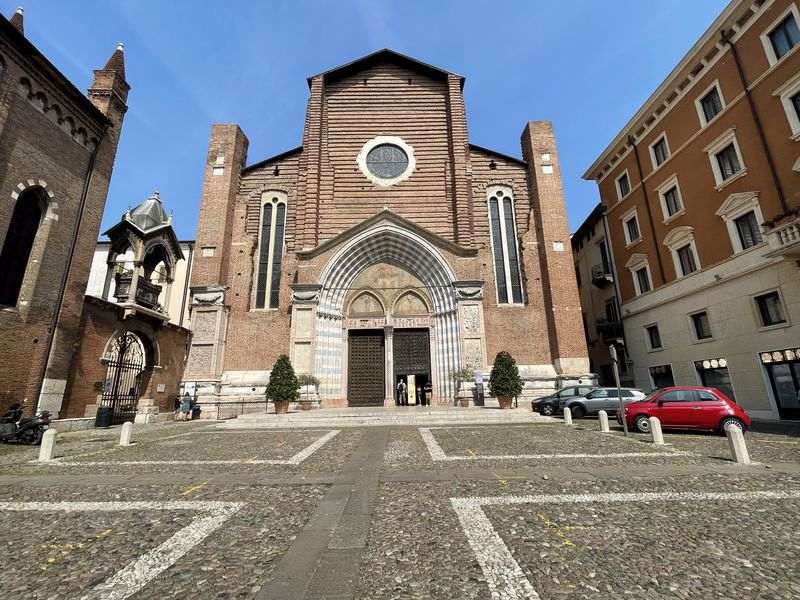
Next church that you should definitely see is the Basilica of St. Zeno (Basilica di San Zeno). Undoubtedly this particular attraction, which was built between 967 and 1398 AD, is one of the most beautiful and best preserved examples of Romanesque architecture in all of Northern Italy! Of course, the reason it is mostly known is because according to Shakespeare, this was the place where the Romeo and Juliet got married!
The third church worth crossing its threshold is Santa Maria Assunta or the Duomo. Essentially it is a complex of religious buildings that include St. John's (S. Giovanni), St. Helena (S. Elena), the monastery of the Canons, the library of the Capitular, the square in front of the church and the residence of the bishop.
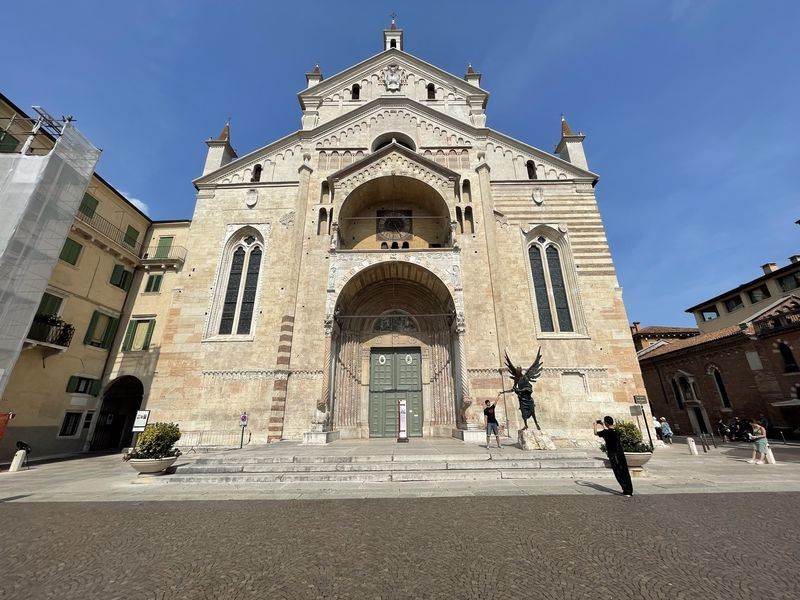
Last but not least, I left the church of St. Fermo (Chiesa di San Fermo Maggiore). This church is located on the banks of the Adige River near Ponte Navi. The date of its construction cannot be said with certainty, since it consists of many independently built pieces, starting from the 8th and reaching up to the 18th century! Admission to each church individually costs 3e, but if you wish to visit all four temples you can obtain a single ticket that costs 6e.
How to go
At the moment Thessaloniki is not directly connected by air to Verona, so if you wish to reach the city only by plane you should make at least one stop. The most economical and flexible option comes from Ryanair, which with proper planning can find tickets starting from 51 € round trip, with a stopover in London! Beyond that, a good solution to travel economically, within the neighboring country is the train, since the railway network is easy to use and convenient. So you could try to find a flight to some other city like Venice or Bologna and from there reach Verona. Something that will certainly save you both time and money.
Where to stay
Verona is a relatively small town, where everything is located close to its historical center; this means that it would be best to find a hotel or apartment, as centrally as possible. The accommodation I have to recommend is the Dreaming Piazza Bra Rooms which is located just 8 minutes walking from Piazza Bra and the Verona Arena and which has comfortable and clean rooms.
How to move
When you are in Verona, you probably will not need to use public transport, as all the attractions are located in the city center and can be easily reached with a short walk. But if your hotel is in the suburbs or if you want to get to a place outside the Verona limit, the city has an excellent public transport network, with buses starting from the train station and covering the whole town. Another good and relatively economical solution for moving, are taxis, which are very easy to stop either on the road or to take from one of the dozens of places that are stopped.
What to eat
Verona is known worldwide for its beautiful medieval old town and the romantic mood, but Veronese cuisine also deserves the attention of the traveler. It is almost impossible not to enjoy the food in the city, as even in places that are explicitly dedicated to crowds of tourists, the level is very high. Famous local dishes worth trying are Risotto with Tastasal (a local cold cut), Risotto all'Amarone cooked with fine Valpolicella wine, Pastissada de Caval resembling Corfiot pastitsada, potato gnocchi, polenda and various desserts with puff pastry! A good choice for dining in the alleys of the old town is the Amo Bistrot, which beautifully combines Asian cuisine with local character. For coffee and aperitivo I recommend the Emanuel Café in Piazza Bra overlooking the Arena and the Casa Mazzanti Caffe in Piazza del Ebre, while for ice cream the Gelateria Ponte Pietra next to the homonymous bridge.
Useful information
In Italy we travel with a Passport or new type Police ID, where the details are written in Latin characters.
In Verona the language used is, of course, Italian. But most, if not all, speak English, so ask for clarification in English.
The country's currency is the Euro.
Verona is one hour behind Greece (GMT +2).
There is no Greek embassy or consulate in Verona, so if you need anything you should contact the nearest one, which is located in Bologna at 67/2 Via dell 'Indipendenza, 40128 and its phone number is (0039051) 4213273.
Getting to and from Verona airports is easy, as there are regular bus services to and from the city center.
The climate of Italy is quite similar to that of Greece, so there are mild winters and hot summers. I consider the autumn or spring to be an ideal time to visit.
For more information on the city of Verona see Visit Verona!
Suggested excursions → Venice, Bologna, Milan
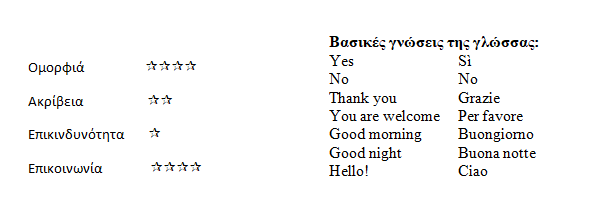
If this article seemed interesting or contributed to your quality information, then you can like my facebook page: o_thessalonikios or follow me on instagram!
Mouzakidis Pantelis








